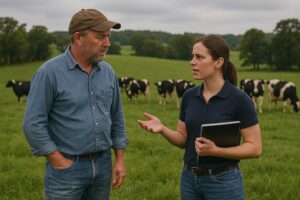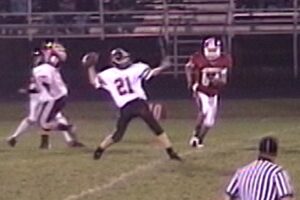There’s a life cycle in every career and being an Ag Sales Professional is no different. In most cases, we start out young, with little experience. If we stick with it, we move into our experienced years, where we climb to success and then move into the waning years of our career.
There’s nothing comparable to your Freshman year. It’s a big change for you as you go from the structure of early school years to the small freedoms that come with being in the big high school. It’s a year of “firsts”. Sophomore year is Round 2. You’ve made some cold calls, met some rejection, been to a few sales meetings and know who the players are. Now it’s time to pick your lane.
Below are a few ideas I thought about as I reflected on my Sophomore year in Ag Sales.
- Hadn’t Found my Crowd Yet
Just like trying to find friends to sit with in the cafeteria. You will eventually connect better with a particular group on the sales team and a type of customer (customer segment). Freshman year is like Forrest Gump trying to find a seat on the bus on day one. You’re a rookie and not a lot of folks are interested in you. Why? They’ve seen dozens, maybe hundreds of sales people just like you. Just starting out, not knowing if you want to be in sales, full of “product” info, spewing the party line. They really don’t want to spend time with a sales person who might not be here in a month. You may remember my story of a prospect pulling out a stack of business cards from previous sales people from my company and tossing them on the desk. Basically, telling me that, he wasn’t interested until I stuck around.
Sophomore year is better. You’re back for another call on prospects. You’re showing that you didn’t leave and you plan to stick around for a while. You start to identify more with people on your team. Maybe it’s a senior sales person that is inclined to mentor you – maybe so you can show them how to do some of the “tech stuff”. I was part of an informal peer group that consisted of two that were younger and a little more tech savvy and two that were a little older and a little less tech savvy. I can still remember when I asked one of the older peers where his Word files were. His answer was, “What are files?”. However, he had been in the business many years, could pull historical situations from past experience and help solve issues. He was also very connected in the Ag community and helped out a lot when I needed to know some of the relationship issues between customers or companies. In addition, we had a lot of fun together.
- Had Moderate Success – Gained Confidence – Bordering on arrogance
Luckily, I had the seniors & prospects to put me in my place (sarcasm). Early success felt amazing. Especially if it was a prospect I found all on my own and took through the whole process. Confidence began to build and once in a while would go too far and turn into a bit of arrogance. As I mention sarcastically, if a senior member of the sales team noticed, this was easily crushed by one their big sales or deals. Use this kind of attention as a motivator and not a set back to your progress.
- Had my first serious Accounts Receivables Issue
As difficult as this was to go through, it was a great lesson in business and human relations. Getting strung along on a $50,000 bill felt devastating to me. Luckily, I had good mentors to help get through it and the company was financially strong enough to survive it. I learned that right or wrong, the local courts will protect a local business person against a large company. Even if that local business is dead wrong and owes the money. I learned that a sheriff will not go out and round up a person that bounces a check if it was paid on a statement/past due. They only do that if the check was presented as cash, like at a grocery store. I learned the reason they write your driver’s license down on your check is because you need proof of the exact person that wrote the check before a sheriff will go out and haul them in for bouncing a check. I also learned that it takes a long, long time to foreclose on property. Longer if you are not in first position like a bank. Mostly, I learned to appreciate the ACH process. I successfully campaigned to raise the ACH discount higher so it became a “no brainer” versus other credit terms. I found that if a customer didn’t go with the higher discounted ACH terms, then there’s probably going to be an issue with getting paid.
- Patterned my success
This was a critical step. Depending on your company & products/services, you need to chase a lot of different leads during these early years to figure out how to have success. However, this may not be as applicable if your company has a very specific methodology or system that they want you to follow or has very specific market segments they want you to call on. However, many of us are given a territory by geography, usually by counties and told to “have at it” or “call us when you sell something”. You may remember my experience around marketing material. The only marketing material I started with was a price list in my top pocket and a stack of feed tags. I shot out in all directions to find anyone and everyone that was willing to buy a bag of feed. Someday, I’ll blog about loading up my mini-van with 10 bags of feed for my first sale. I should say donation, because I don’t remember if we got paid for it.
Key to this step was figuring out where and when I had leverage to close a sale. Who or what type of prospect found value in what I had to offer. Not necessarily my products, but me as their sales person. Once I patterned where, when and who I connected with, I moved to the next step. How do I find more of these people?
- Locating Prospects
Now you need to find them. Where can I get in front of the largest group of my best prospects? Most sales training starts with you standing in front of your prospect. Very few deal with ways to find those prospects or better yet, how to determine who those prospects are. A shameless plug for my training – mine does. Anyway, you need to find them. If you are a hunter or fisherman, then you know exactly what to do. You find out where the heaviest concentration of bass or deer are and then – you Go There! See my reference in a previous blog about fishing in a swimming pool. Not very productive. Go where the prospects gather.
I’m sure there were many more lessons from my sophomore year, but I hope this proves helpful for you along the way. If you’ve been out selling a while, I’m sure you can see yourself in these situations. If you’re new, just know that you probably aren’t the first to go through these experiences. Reach out and share with a peer or more experienced sales person and learn from both the right and wrong ways.
To find out how I can work with you or your team, contact me directly at Greg@GregMartinelli.net
For more on Ag Sales Training, Ag Sales Coaching and Leading Ag Sales Teams, go to: http://www.GregMartinelli.net/
From previous blog on my Freshman year as an Ag Sales Professional.
For the rest of the story go to: http://gregmartinelli.net/life-times-ag-sales-professional-early-years/
Things I did Right:
- Called on the real end user so I could better understand my customer (dealer)
- Got Extremely Organized
- Asked for advice all the time
- Went on peer ride alongs that were both nearby and in other geographies
- Knew and kept up on our internal processes and procedures
- Knew my competition better than they knew themselves – or so I thought
- Self-improvement
- Went anywhere and everywhere and sold everyone in between
Things I did Wrong:
- Went anywhere and everywhere and sold everyone in between
- Customized everything
- Trusted a few Accounts Receivable situations that I probably wouldn’t today
- Talked too much during the sales process
- Presented the marketing material as is – failing to make it come from me



